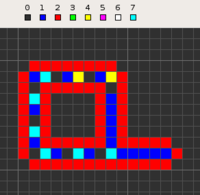Langton's loops

Langton's loops are a cool thing that happens when you play a game on a grid. Imagine you have a bunch of little squares arranged in a big square grid, like a checkerboard. You can color in some of these squares, or leave them blank.
Now let's pretend you have a tiny little bug that can move around on this grid. The bug can only go forwards, backwards, left, or right, but it can go over any colored or blank squares. Whenever the bug lands on a square, it does something special. If the square is colored in, the bug changes direction by turning 90 degrees to the right. If the square is blank, the bug turns 90 degrees to the left.
Now here's where things get really interesting: when you start moving your bug around the grid, it will often start to create little patterns or loops as it moves. Sometimes the loops are simple and small, but other times they can grow really big and complex.
Scientists who study math and computer science really like Langton's loops because they are super unpredictable - even though the rules for how the bug moves are really simple, the patterns it creates are never exactly the same twice. It's kind of like making art with a robot that's really good at improvising!
Now let's pretend you have a tiny little bug that can move around on this grid. The bug can only go forwards, backwards, left, or right, but it can go over any colored or blank squares. Whenever the bug lands on a square, it does something special. If the square is colored in, the bug changes direction by turning 90 degrees to the right. If the square is blank, the bug turns 90 degrees to the left.
Now here's where things get really interesting: when you start moving your bug around the grid, it will often start to create little patterns or loops as it moves. Sometimes the loops are simple and small, but other times they can grow really big and complex.
Scientists who study math and computer science really like Langton's loops because they are super unpredictable - even though the rules for how the bug moves are really simple, the patterns it creates are never exactly the same twice. It's kind of like making art with a robot that's really good at improvising!
Related topics others have asked about:
